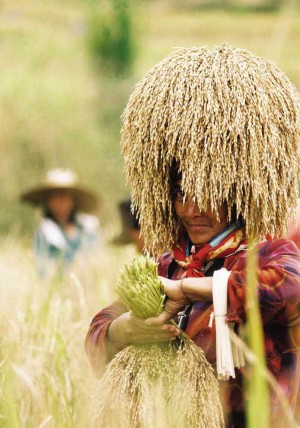One grain at a time

PRECIOUS GRAINS A farmer harvests “kintoman,” an heirloom rice variety, grown in the fields of Maligcong village in Bontoc town, Mt. Province. EV ESPIRITU
Crisis or not, the supply of locally grown rice is constantly threatened by erratic weather, land conversion and even people’s changing diet.
But at the Philippine Rice Research Institute (PhilRice) in Nueva Ecija province, scientists are working day and night to save the Filipinos’ staple, one grain at a time.
PhilRice’s seed bank holds the key in ensuring that the country’s traditional rice varieties, even those that local farmers are not using anymore, will feed generations.
“These should be conserved as these are not only important as the building blocks in breeding new varieties, but these are part of our national heritage as well,” says Dr. Eufemio Rasco Jr., PhilRice executive director.
Rasco says some rice varieties, especially those used several centuries ago, may have been lost forever. “But out there in some of the country’s 7,100 islands, there may still be real treasures, in the form of traditional varieties not yet conserved,” he says.
Our ancestors ate root crops, Rasco says, but early migrants brought rice to the country, eventually becoming the local staple.
According to PhilRice, modern rice varieties came from the wild grains that grew in the extinct super continent called “Gondwanaland” (land masses in today’s southern hemisphere) that drifted apart to become Asia, Africa, Australia and Antartica.
It was China that started domesticating rice by developing a process of cultivating the soil and refining the system of transplanting it, PhilRice says.
Archaeologists, it says, found evidence of the use of wild and cultivated rice around 3,200 B.C. in the Andarayan plain in Cagayan province.
PhilRice says that people in the country at that time were “in a state of settled society and no longer moving around in groups to hunt, gather berries and leaves.”
Also, the ancestors of the Ifugao people built the rice terraces in the Cordillera mountain ranges to cultivate upland rice. Until now, PhilRice says, farmers in Ifugao province are planting “heirloom rice” in those terraced farms.
Rasco says it was in the 1900s that efforts to collect rice seeds for conservation started. Rice breeders from the Bureau of Plant Industry (BPI) and the College of Agriculture of the University of the Philippines at Los Baños in Laguna province, he says, helped in efforts to preserve the country’s rice varieties.
In the early 1960s, separate collections were consolidated by the International Rice Research Institute (Irri) in its facility in Los Baños. Through this, local rice seeds and those grown in other countries were deposited in the agency’s seed bank.
Seed collection
Irri keeps a seed collection representing about a fifth of the world’s 500,000 rice varieties.
In 1985, PhilRice put up its own seed bank, the PhilRice Genebank, composed of the duplicated seeds of Philippine rice varieties at Irri and from its own efforts in collecting them.
“We are doing our best efforts in conserving them. But these can only last for as long as funding continues because maintaining these seeds is very, very expensive,” Rasco says.
Loida Moreno-Perez, chief of PhilRice’s genetic resources division, says the agency has 7,129 “accessioned” rice varieties or those that have been fully documented and packaged.
Her division takes care of the germplasm management, conservation, distribution and use of the conserved varieties. Germplasm is a collection of genetic resources for an organism. For plants, the germplasm may be stored as a seed collection.
Accessioned varieties, Perez says, have “passport” data (background information, history, and cultural and conservation processes), samples of seeds and images of in situ (in site) cultivation. More than 13,000 varieties in PhilRice’s collection have yet to undergo accessioning, she says.
The accessioned seeds in packets of 50 grams and 200 grams, which include foreign rice varieties, are kept in storage rooms. The 50-gram packets are stored in freezers (at negative 18 degrees Celsius) for long-term conservation while the 200-gram seeds are for short-term conservation and kept in a temperature of 10 to 11 degrees Celsius.
“The short-term conserved seeds are distributed, on request, to researchers and students. They are given 10 grams of the samples per request,” she says.
Rejuvenated
She says the seeds intended for distribution are “rejuvenated,” or grown and stored again, every five years.
Perez says PhilRice needs a better facility to keep the growing number of seeds. “More samples are coming in through our collectors, farmers and others who are donating them for our conservation efforts,” she says.
Rasco gives assurance that PhilRice is planning to improve the gene bank through funds that would be generated by a foundation.
“As a breeder, I know the importance of these rice seeds. They are the raw materials for breeding new rice varieties…. They are survivors of stresses, pests and diseases that is why they are our wealth,” he says.














